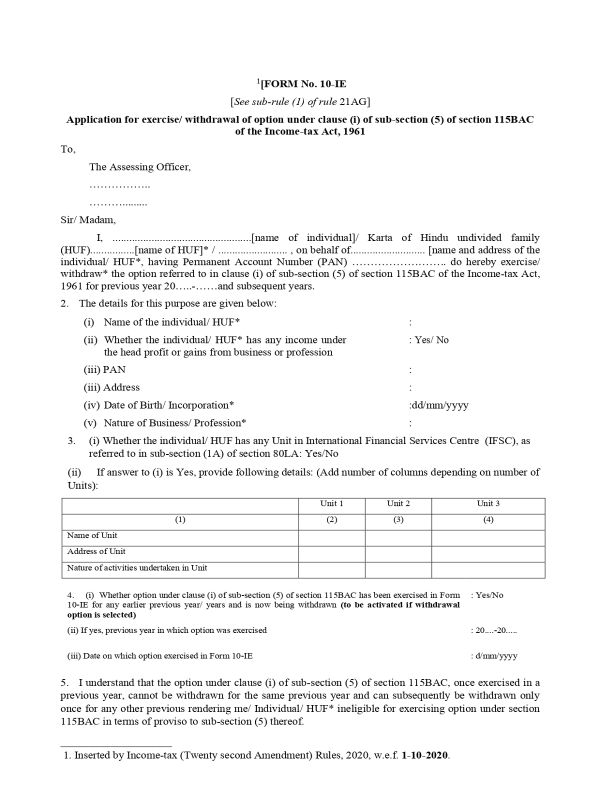
Form 10IE- Option to choose New tax regime | How to Submit Form 10IE online?
Form 10-IE was a mandatory form used by taxpayers to opt for the new tax regime before FY 2023-24, when the old regime was the default. It applied mainly to individuals and HUFs with business or professional income. From FY 2023-24, the new regime became the default, and Form 10-IE was discontinued, replaced by Form 10-IEA.
Key Highlights
- Form 10-IE has been discontinued as of FY 2024-25.
- To switch between the old and new tax regimes, taxpayers must now file Form 10-IEA.
- Form 10-IEA must be filed before the due date of ITR filing, i.e., 15th September 2025 (for AY 2025-26).
What is Form-10IE?
Form 10-IE was a statutory form that taxpayers had to file in order to opt for the new tax regime before FY 2023-24, when the old tax regime was the default option. It was applicable to individuals and HUFs having income from business or profession. Salaried individuals filing ITR-1 or ITR-2 were not required to submit Form 10-IE.
However, the Union Budget 2023 amended the tax provisions and made the new tax regime the default regime from FY 2023-24 onwards. As a result, Form 10-IE has been discontinued from FY 2023-24.
Now, if taxpayers wish to shift from the default new regime to the old regime, they must file Form 10-IEA on or before the due date of filing the return.
What is The New Tax Regime?
The new tax regime offers lower tax rates; however, most of the deductions and exemptions available under the old regime are not allowed. From FY 2023-24, the new tax regime has become the default regime. If a taxpayer wishes to switch to the old regime, they must file Form 10-IEA on or before the due date, since Form 10-IE is no longer available for this purpose.
Click here to check the income tax slabs applicable to you under both the new and old tax regimes.
When to Submit Form 10IE?
Form 10IE has to be filed BEFORE filing your income tax return. After submitting Form 10IE, a 15-digit acknowledgement number will be generated. Taxpayers cannot proceed with their ITR filing under the new tax regime without mentioning this 15-digit acknowledgement number.
How to Switch Between Old and New Tax Regime?
- For FY 2022-23 and earlier:
- The old regime was the default.
- To opt for the new regime, taxpayers with business/professional income had to file Form 10-IE before filing their ITR.
- Salaried individuals (without business/professional income) could directly choose the regime while filing ITR without Form 10-IE.
- From FY 2023-24 onwards:
- The new regime is the default.
- If taxpayers wish to continue with the old regime, they must file Form 10-IEA on or before the due date of ITR filing.
- Salaried individuals can switch between the regimes every year while filing ITR.
- Taxpayers with business/professional income can switch back to the old regime by filing Form 10-IEA, but once opted out, they cannot revert to the new regime unless their business/professional income ceases.
How to File Form 10IE?
Follow these steps for filing Form 10IE online:
Step 1: Login on the e-filing portal
Step 2: On the dashboard, click ‘e-File’ > ‘Income tax forms’ > ‘File Income Tax Forms’
Step 3: Scroll down to select Form 10-IE. Alternatively, enter Form 10-IE in the search box. Click on ‘File now’ button to proceed.
Step 4: Select the Assessment Year for which you are filing the return. For eg: If you are filing taxes for the income earned in FY 2022-23, then select AY 2023-24.
Step 5: On clicking 'Let's Get Started', Form 10-IE will be displayed. Form 10-IE has 4 sections:
(a) Assessing Officer
(b) Basic Information
(c) Additional Information
(d) Verification
First section is ‘Assessing Officer’. The details in this section are pre-filled. You only have to ‘confirm’ these details.
Step 6: Basic Information
Under Basic Information section, all your basic information like Name, PAN, Address are auto-filled. You will be required to provide the following information:
- Whether you have any income from business or profession? (Select ‘Yes’)
- Now select the ‘Nature of Business’. You may choose multiple business codes, if applicable.
Step 7: Additional Information
- Under this section, you will be required to provide details of IFSC units (if any) and provide the required details like name and address of the unit and nature of business.
- Select "Yes" if you opted for the new regime in any of the previous years but are now opting for the old regime in the current year. Once done, save the information
Step 8: Verification
Verification section contains self-declaration where you will be required to check the boxes and agree to the terms and conditions. Verify whether all the details are correct and save the information. Once done, click on ‘Preview’ to review Form 10IE.
Step 9: After reviewing all the information, ‘Proceed’ to e-verify'. You can e-verify either through:
- Aadhaar OTP
- Digital Signature Certificate (DSC)
- Electronic Verification Code (EVC)
Step 10: After successful e-Verification, a success message is displayed along with a Transaction ID and an Acknowledgement Receipt Number. Please keep a note of the Transaction ID and Acknowledgement number for future reference. You will also receive a confirmation message on your email ID registered with the e-Filing portal. You can also download the form and locate the acknowledgment number.
To download the filed form, go to ‘e-File’ → 'Income Tax Forms' → 'View Filed Forms'.
Step 11: After submitting the form, you may proceed with filing your return. On ClearTax, go to the 'Tax Summary' tab and add the required details under ‘Form 10-IE’ section as shown below.
Contents of Form 10IE
Basic details required to file Form 10IE are mentioned below:
- Name of the individual/HUF
- Confirmation of whether the individual or HUF have any income under ‘Profit or gains from business and profession.
- PAN number
- Address
- Date of birth/date of incorporation
- Nature of business/profession (mandatory in case of business income)
- Confirmation in ‘yes/no’ of whether the taxpayer has any unit in IFSC (International Financial Service Centre) as mentioned in sub-section (1A) of section 80LA. Suppose the answer is ‘Yes’, then details of the unit to be provided.
- Details of Form 10IE previously filed.
- Declaration


e-Filing of Form 10IE
- The taxpayers should file Form 10IE electronically on the income tax e-filing portal
- The form must be e-verified using either the digital signature certificate or through an Electronic Verification Code (EVC) or Aadhaar OTP.
Related Articles :
Section 115BAC-New tax regime
Old tax Regime Vs New tax regime
Calculate taxes in Old Vs New tax regime
Form 10-IEA: Option to Choose Old Tax Regime
Frequently Asked Questions



